Seat Ibiza ST 2016 Repair Manual
Manufacturer: SEAT, Model Year: 2016, Model line: Ibiza ST, Model: Seat Ibiza ST 2016Pages: 252, PDF Size: 5.56 MB
Page 61 of 252
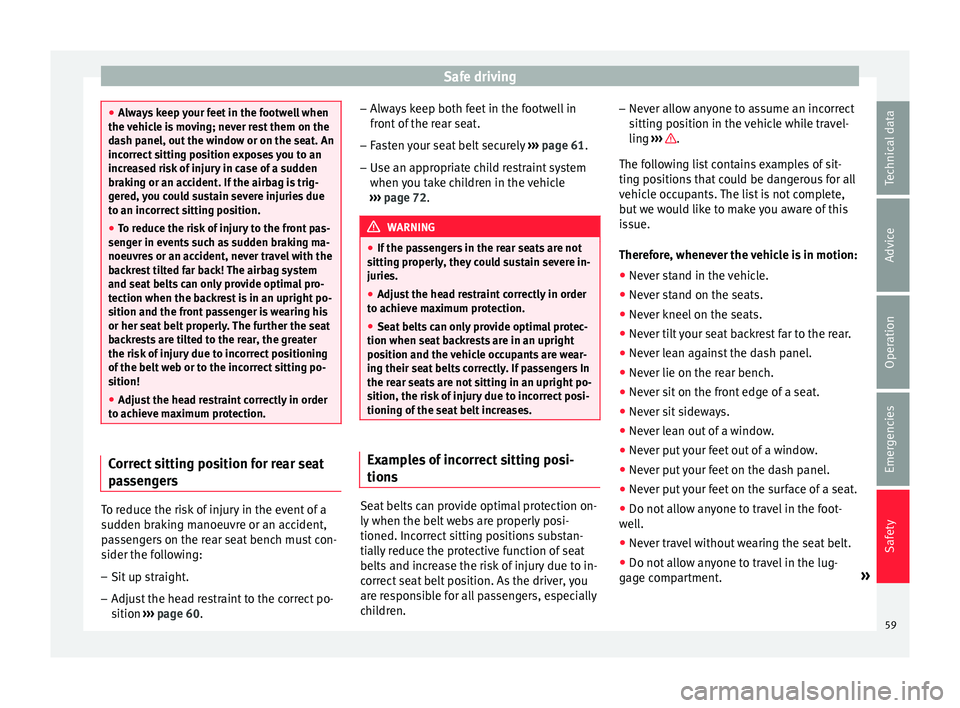
Safe driving
●
Alwa y
s keep your feet in the footwell when
the vehicle is moving; never rest them on the
dash panel, out the window or on the seat. An
incorrect sitting position exposes you to an
increased risk of injury in case of a sudden
braking or an accident. If the airbag is trig-
gered, you could sustain severe injuries due
to an incorrect sitting position.
● To reduce the risk of injury to the front pas-
senger in event
s such as sudden braking ma-
noeuvres or an accident, never travel with the
backrest tilted far back! The airbag system
and seat belts can only provide optimal pro-
tection when the backrest is in an upright po-
sition and the front passenger is wearing his
or her seat belt properly. The further the seat
backrests are tilted to the rear, the greater
the risk of injury due to incorrect positioning
of the belt web or to the incorrect sitting po-
sition!
● Adjust the head restraint correctly in order
to achieve m
aximum protection. Correct sitting position for rear seat
p
a
ssen
gers To reduce the risk of injury in the event of a
s
ud
den br ak
ing manoeuvre or an accident,
passengers on the rear seat bench must con-
sider the following:
– Sit up straight.
– Adjust the head restraint to the correct po-
sition ›››
page 60. –
Alway
s keep both feet in the footwell in
front of the rear seat.
– Fasten your seat belt securely ››› p
age 61.
– Use an appropriate child restraint system
when you tak
e children in the vehicle
››› page 72. WARNING
● If the pa s
sengers in the rear seats are not
sitting properly, they could sustain severe in-
juries.
● Adjust the head restraint correctly in order
to achieve m
aximum protection.
● Seat belts can only provide optimal protec-
tion when seat bac
krests are in an upright
position and the vehicle occupants are wear-
ing their seat belts correctly. If passengers In
the rear seats are not sitting in an upright po-
sition, the risk of injury due to incorrect posi-
tioning of the seat belt increases. Examples of incorrect sitting posi-
tion
s Seat belts can provide optimal protection on-
ly
when the belt
we
bs are properly posi-
tioned. Incorrect sitting positions substan-
tially reduce the protective function of seat
belts and increase the risk of injury due to in-
correct seat belt position. As the driver, you
are responsible for all passengers, especially
children. –
Never allow an
yone to assume an incorrect
sitting position in the vehicle while travel-
ling ››› .
The f o
llo
wing list contains examples of sit-
ting positions that could be dangerous for all
vehicle occupants. The list is not complete,
but we would like to make you aware of this
issue.
Therefore, whenever the vehicle is in motion:
● Never stand in the vehicle.
● Never stand on the seats.
● Never kneel on the seats.
● Never tilt your seat backrest far to the rear.
● Never lean against the dash panel.
● Never lie on the rear bench.
● Never sit on the front edge of a seat.
● Never sit sideways.
● Never lean out of a window.
● Never put your feet out of a window.
● Never put your feet on the dash panel.
● Never put your feet on the surface of a seat.
● Do not allow anyone to travel in the foot-
well.
● Nev
er travel without wearing the seat belt.
● Do not allow anyone to travel in the lug-
gage comp
artment. »
59
Technical data
Advice
Operation
Emergencies
Safety
Page 62 of 252
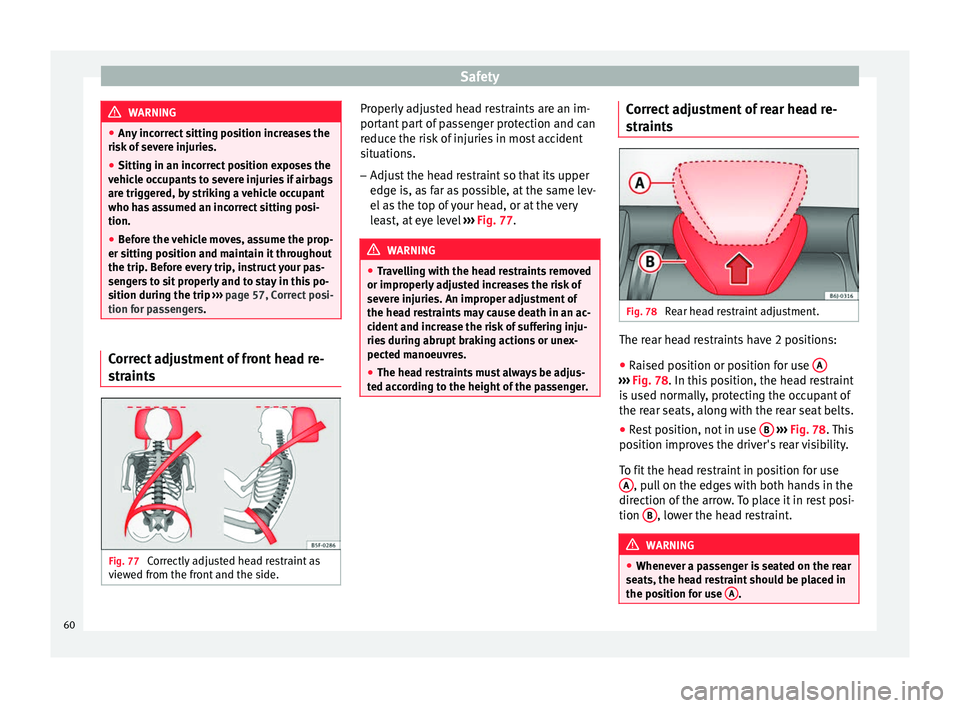
Safety
WARNING
● Any inc orr
ect sitting position increases the
risk of severe injuries.
● Sitting in an incorrect position exposes the
vehicle oc
cupants to severe injuries if airbags
are triggered, by striking a vehicle occupant
who has assumed an incorrect sitting posi-
tion.
● Before the vehicle moves, assume the prop-
er sitting pos
ition and maintain it throughout
the trip. Before every trip, instruct your pas-
sengers to sit properly and to stay in this po-
sition during the trip ››› page 57, Correct posi-
tion for passengers. Correct adjustment of front head re-
s
tr
aint s Fig. 77
Correctly adjusted head restraint as
v iew
ed fr om the fr
ont and the side. Properly adjusted head restraints are an im-
por
t
ant p
art of passenger protection and can
reduce the risk of injuries in most accident
situations.
– Adjust the head restraint so that its upper
edge is, as
far as possible, at the same lev-
el as the top of your head, or at the very
least, at eye level ››› Fig. 77. WARNING
● Trav el
ling with the head restraints removed
or improperly adjusted increases the risk of
severe injuries. An improper adjustment of
the head restraints may cause death in an ac-
cident and increase the risk of suffering inju-
ries during abrupt braking actions or unex-
pected manoeuvres.
● The head restraints must always be adjus-
ted accor
ding to the height of the passenger. Correct adjustment of rear head re-
s
tr
aint s Fig. 78
Rear head restraint adjustment. The rear head restraints have 2 positions:
● Raised position or position for use A ›››
Fig. 78. In this po s ition, the head restraint
is used normally, protecting the occupant of
the rear seats, along with the rear seat belts.
● Rest position, not in use B
› ›
› Fig. 78 .
This
position improves the driver's rear visibility.
To fit the head restraint in position for use A , pull on the edges with both hands in the
dir ection of
the arro
w. To place it in rest posi-
tion B , lower the head restraint.
WARNING
● Whenever a pa s
senger is seated on the rear
seats, the head restraint should be placed in
the position for use A .
60
Page 63 of 252
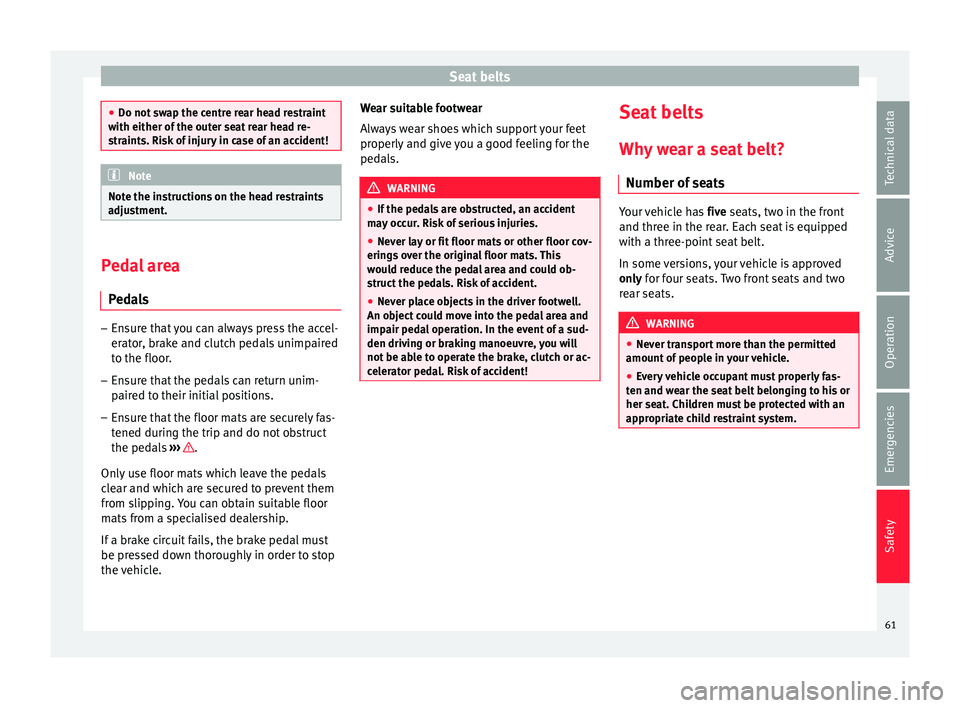
Seat belts
●
Do not swap the c entr
e rear head restraint
with either of the outer seat rear head re-
straints. Risk of injury in case of an accident! Note
Note the instructions on the head restraints
a djus tment
.Pedal area
P ed
al
s –
Ensure that you can always press the accel-
er at
or , br
ake and clutch pedals unimpaired
to the floor.
– Ensure that the pedals can return unim-
paired to their initi
al positions.
– Ensure that the floor mats are securely fas-
tened during the trip and do not o
bstruct
the pedals ››› .
On ly
u se floor m
ats which leave the pedals
clear and which are secured to prevent them
from slipping. You can obtain suitable floor
mats from a specialised dealership.
If a brake circuit fails, the brake pedal must
be pressed down thoroughly in order to stop
the vehicle. Wear suitable footwear
Alway
s wear shoes which support your feet
properly and give you a good feeling for the
pedals. WARNING
● If the peda l
s are obstructed, an accident
may occur. Risk of serious injuries.
● Never lay or fit floor mats or other floor cov-
erings o
ver the original floor mats. This
would reduce the pedal area and could ob-
struct the pedals. Risk of accident.
● Never place objects in the driver footwell.
An object
could move into the pedal area and
impair pedal operation. In the event of a sud-
den driving or braking manoeuvre, you will
not be able to operate the brake, clutch or ac-
celerator pedal. Risk of accident! Seat belts
Wh y
w e
ar a seat belt?
Number of seats Your vehicle has
five seats, tw
o in the front
and three in the rear. Each seat is equipped
with a three-point seat belt.
In some versions, your vehicle is approved
only for four seats. Two front seats and two
rear seats. WARNING
● Never tran s
port more than the permitted
amount of people in your vehicle.
● Every vehicle occupant must properly fas-
ten and wear the se
at belt belonging to his or
her seat. Children must be protected with an
appropriate child restraint system. 61
Technical data
Advice
Operation
Emergencies
Safety
Page 64 of 252
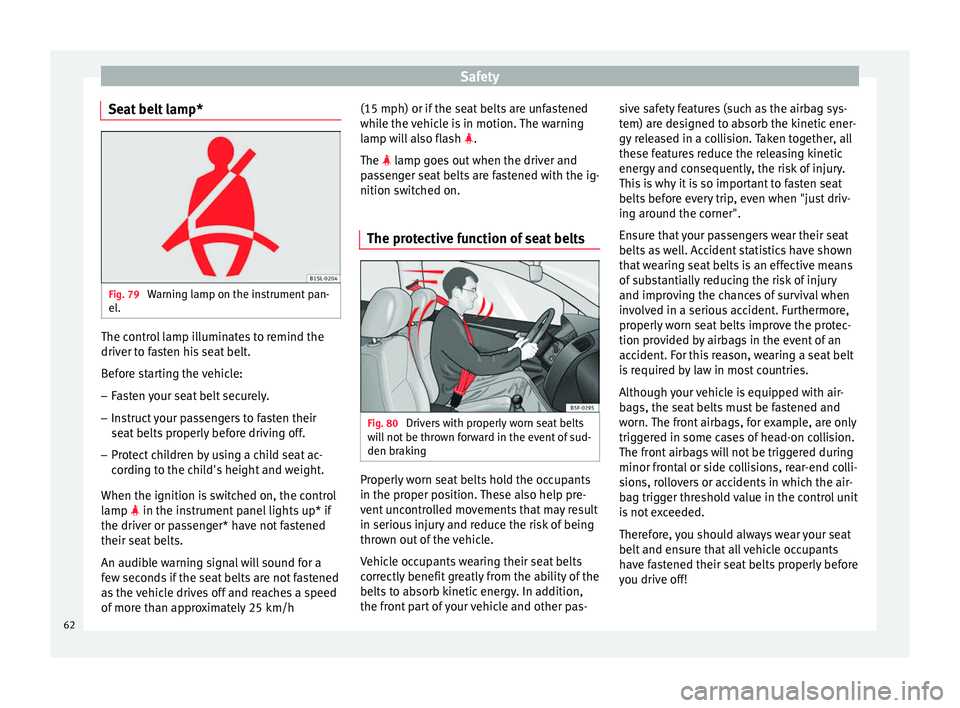
Safety
Seat belt lamp* Fig. 79
Warning lamp on the instrument pan-
el . The control lamp illuminates to remind the
driv
er t
o fa
sten his seat belt.
Before starting the vehicle: – Fasten your seat belt securely.
– Instruct your passengers to fasten their
seat belts pr
operly before driving off.
– Protect children by using a child seat ac-
cording t
o the child's height and weight.
When the ignition is switched on, the control
lamp in the instrument panel lights up* if
the driver or passenger* have not fastened
their seat belts.
An audible warning signal will sound for a
few seconds if the seat belts are not fastened
as the vehicle drives off and reaches a speed
of more than approximately 25 km/h (15 mph) or if the seat belts are unfastened
while the v
ehicle is in motion. The warning
lamp will also flash .
The lamp goes out when the driver and
passenger seat belts are fastened with the ig-
nition switched on.
The protective function of seat belts Fig. 80
Drivers with properly worn seat belts
w i
ll
not be thrown forward in the event of sud-
den braking Properly worn seat belts hold the occupants
in the pr
oper po
sition.
These also help pre-
vent uncontrolled movements that may result
in serious injury and reduce the risk of being
thrown out of the vehicle.
Vehicle occupants wearing their seat belts
correctly benefit greatly from the ability of the
belts to absorb kinetic energy. In addition,
the front part of your vehicle and other pas- sive safety features (such as the airbag sys-
tem) are des
igned to absorb the kinetic ener-
gy released in a collision. Taken together, all
these features reduce the releasing kinetic
energy and consequently, the risk of injury.
This is why it is so important to fasten seat
belts before every trip, even when "just driv-
ing around the corner".
Ensure that your passengers wear their seat
belts as well. Accident statistics have shown
that wearing seat belts is an effective means
of substantially reducing the risk of injury
and improving the chances of survival when
involved in a serious accident. Furthermore,
properly worn seat belts improve the protec-
tion provided by airbags in the event of an
accident. For this reason, wearing a seat belt
is required by law in most countries.
Although your vehicle is equipped with air-
bags, the seat belts must be fastened and
worn. The front airbags, for example, are only
triggered in some cases of head-on collision.
The front airbags will not be triggered during
minor frontal or side collisions, rear-end colli-
sions, rollovers or accidents in which the air-
bag trigger threshold value in the control unit
is not exceeded.
Therefore, you should always wear your seat
belt and ensure that all vehicle occupants
have fastened their seat belts properly before
you drive off!
62
Page 65 of 252
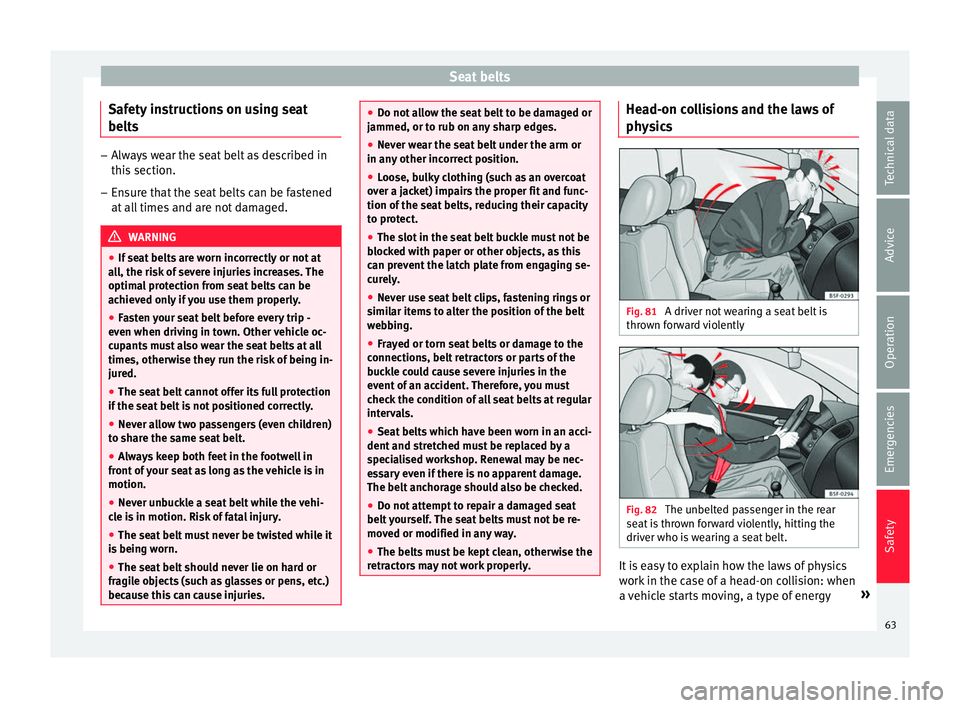
Seat belts
Safety instructions on using seat
belt s –
Always wear the seat belt as described in
this section.
– En s
ure that the seat belts can be fastened
at all time
s and are not damaged. WARNING
● If seat belt
s are worn incorrectly or not at
all, the risk of severe injuries increases. The
optimal protection from seat belts can be
achieved only if you use them properly.
● Fasten your seat belt before every trip -
even when driving in t
own. Other vehicle oc-
cupants must also wear the seat belts at all
times, otherwise they run the risk of being in-
jured.
● The seat belt cannot offer its full protection
if the seat belt
is not positioned correctly.
● Never allow two passengers (even children)
to share the s
ame seat belt.
● Always keep both feet in the footwell in
front of
your seat as long as the vehicle is in
motion.
● Never unbuckle a seat belt while the vehi-
cle is
in motion. Risk of fatal injury.
● The seat belt must never be twisted while it
is being w
orn.
● The seat belt should never lie on hard or
fragile o
bjects (such as glasses or pens, etc.)
because this can cause injuries. ●
Do not al lo
w the seat belt to be damaged or
jammed, or to rub on any sharp edges.
● Never wear the seat belt under the arm or
in any other incorr
ect position.
● Loose, bulky clothing (such as an overcoat
over a jac
ket) impairs the proper fit and func-
tion of the seat belts, reducing their capacity
to protect.
● The slot in the seat belt buckle must not be
blocked w
ith paper or other objects, as this
can prevent the latch plate from engaging se-
curely.
● Never use seat belt clips, fastening rings or
similar it
ems to alter the position of the belt
webbing.
● Frayed or torn seat belts or damage to the
connections, belt r
etractors or parts of the
buckle could cause severe injuries in the
event of an accident. Therefore, you must
check the condition of all seat belts at regular
intervals.
● Seat belts which have been worn in an acci-
dent and stret
ched must be replaced by a
specialised workshop. Renewal may be nec-
essary even if there is no apparent damage.
The belt anchorage should also be checked.
● Do not attempt to repair a damaged seat
belt your
self. The seat belts must not be re-
moved or modified in any way.
● The belts must be kept clean, otherwise the
retractor
s may not work properly. Head-on collisions and the laws of
ph
y
sic
s Fig. 81
A driver not wearing a seat belt is
thr o
wn f or
ward violently Fig. 82
The unbelted passenger in the rear
se at
is
thrown forward violently, hitting the
driver who is wearing a seat belt. It is easy to explain how the laws of physics
w
ork
in the c a
se of a head-on collision: when
a vehicle starts moving, a type of energy »
63
Technical data
Advice
Operation
Emergencies
Safety
Page 66 of 252
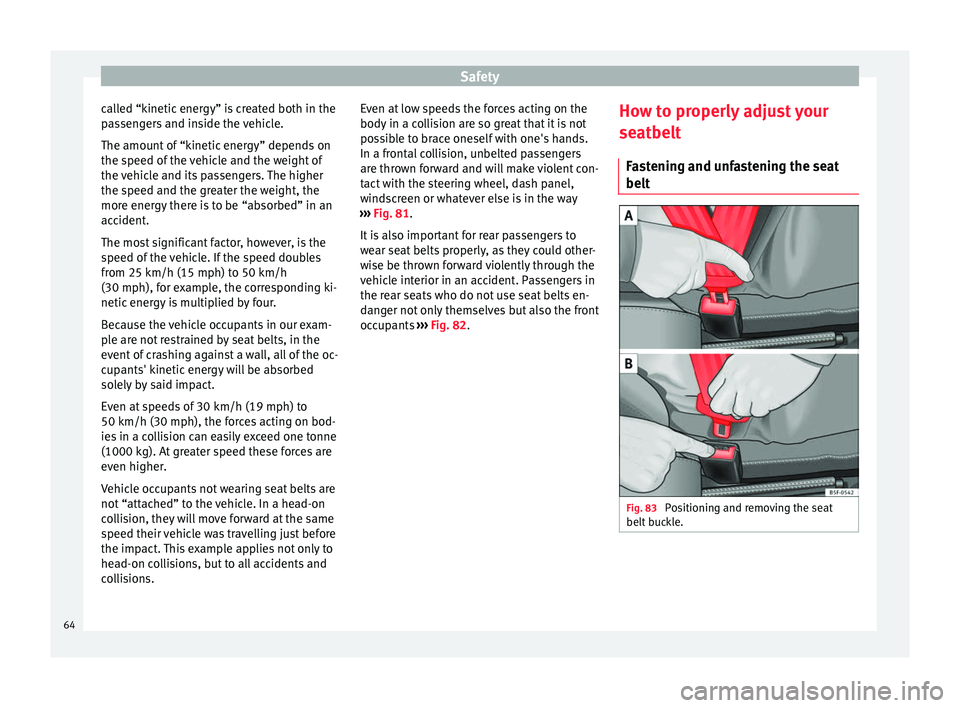
Safety
called “kinetic energy” is created both in the
p a
ssen
gers and inside the vehicle.
The amount of “kinetic energy” depends on
the speed of the vehicle and the weight of
the vehicle and its passengers. The higher
the speed and the greater the weight, the
more energy there is to be “absorbed” in an
accident.
The most significant factor, however, is the
speed of the vehicle. If the speed doubles
from 25 km/h (15 mph) to 50 km/h
(30 mph), for example, the corresponding ki-
netic energy is multiplied by four.
Because the vehicle occupants in our exam-
ple are not restrained by seat belts, in the
event of crashing against a wall, all of the oc-
cupants' kinetic energy will be absorbed
solely by said impact.
Even at speeds of 30 km/h (19 mph) to
50 km/h (30 mph), the forces acting on bod-
ies in a collision can easily exceed one tonne
(1000 kg). At greater speed these forces are
even higher.
Vehicle occupants not wearing seat belts are
not “attached” to the vehicle. In a head-on
collision, they will move forward at the same
speed their vehicle was travelling just before
the impact. This example applies not only to
head-on collisions, but to all accidents and
collisions. Even at low speeds the forces acting on the
body in a col
lision are so great that it is not
possible to brace oneself with one's hands.
In a frontal collision, unbelted passengers
are thrown forward and will make violent con-
tact with the steering wheel, dash panel,
windscreen or whatever else is in the way
››› Fig. 81.
It is also important for rear passengers to
wear seat belts properly, as they could other-
wise be thrown forward violently through the
vehicle interior in an accident. Passengers in
the rear seats who do not use seat belts en-
danger not only themselves but also the front
occupants ››› Fig. 82. How to properly adjust your
seatbelt
Fa
stening and unfastening the seat
belt Fig. 83
Positioning and removing the seat
belt b
uc k
le. 64
Page 67 of 252
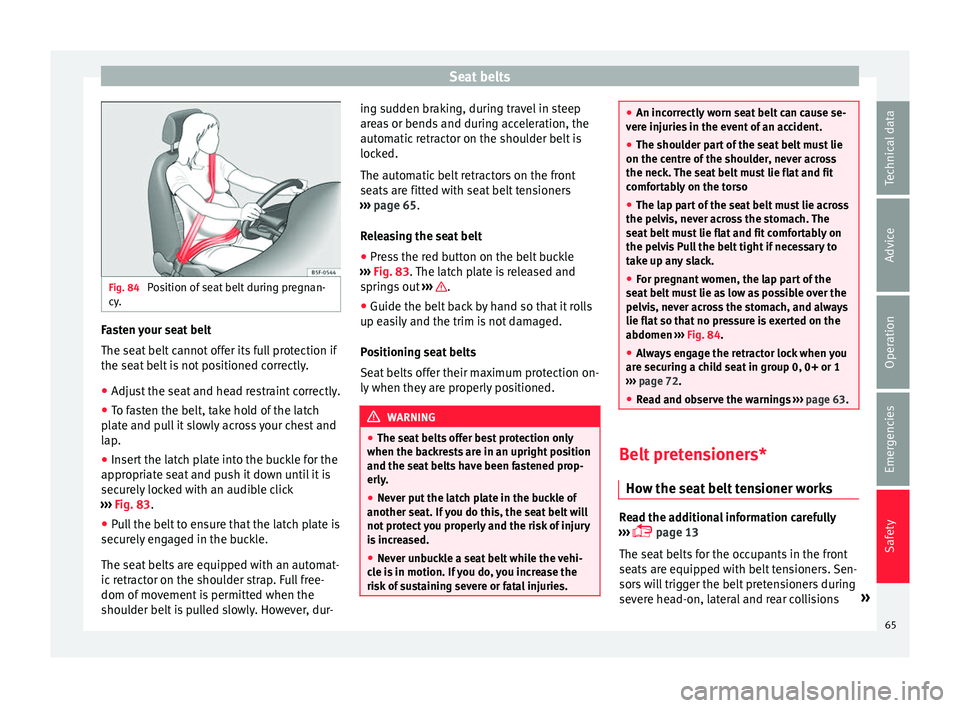
Seat belts
Fig. 84
Position of seat belt during pregnan-
cy . Fasten your seat belt
The se
at
belt c
annot offer its full protection if
the seat belt is not positioned correctly.
● Adjust the seat and head restraint correctly.
● To fasten the belt, take hold of the latch
plate and p
ull it slowly across your chest and
lap.
● Insert the latch plate into the buckle for the
appropriat
e seat and push it down until it is
securely locked with an audible click
››› Fig. 83.
● Pull the belt to ensure that the latch plate is
securely en
gaged in the buckle.
The seat belts are equipped with an automat-
ic retractor on the shoulder strap. Full free-
dom of movement is permitted when the
shoulder belt is pulled slowly. However, dur- ing sudden braking, during travel in steep
areas
or bends and during acceleration, the
automatic retractor on the shoulder belt is
locked.
The automatic belt retractors on the front
seats are fitted with seat belt tensioners
››› page 65.
Releasing the seat belt ● Press the red button on the belt buckle
››› Fig. 83
. The latch plate is released and
springs out ››› .
● Guide the belt back by hand so that it rolls
up e a
si
ly and the trim is not damaged.
Positioning seat belts
Seat belts offer their maximum protection on-
ly when they are properly positioned. WARNING
● The seat belt s
offer best protection only
when the backrests are in an upright position
and the seat belts have been fastened prop-
erly.
● Never put the latch plate in the buckle of
another seat. If
you do this, the seat belt will
not protect you properly and the risk of injury
is increased.
● Never unbuckle a seat belt while the vehi-
cle is
in motion. If you do, you increase the
risk of sustaining severe or fatal injuries. ●
An incorrectly w
orn seat belt can cause se-
vere injuries in the event of an accident.
● The shoulder part of the seat belt must lie
on the centre of the shou
lder, never across
the neck. The seat belt must lie flat and fit
comfortably on the torso
● The lap part of the seat belt must lie across
the pelvis, never ac
ross the stomach. The
seat belt must lie flat and fit comfortably on
the pelvis Pull the belt tight if necessary to
take up any slack.
● For pregnant women, the lap part of the
seat belt mu
st lie as low as possible over the
pelvis, never across the stomach, and always
lie flat so that no pressure is exerted on the
abdomen ››› Fig. 84.
● Always engage the retractor lock when you
are securing a c
hild seat in group 0, 0+ or 1
››› page 72.
● Read and observe the warnings ››› p
age 63. Belt pretensioners*
Ho w the se at
belt
tensioner works Read the additional information carefully
› ›
›
p
age 13
The seat belts for the occupants in the front
seats are equipped with belt tensioners. Sen-
sors will trigger the belt pretensioners during
severe head-on, lateral and rear collisions »
65
Technical data
Advice
Operation
Emergencies
Safety
Page 68 of 252
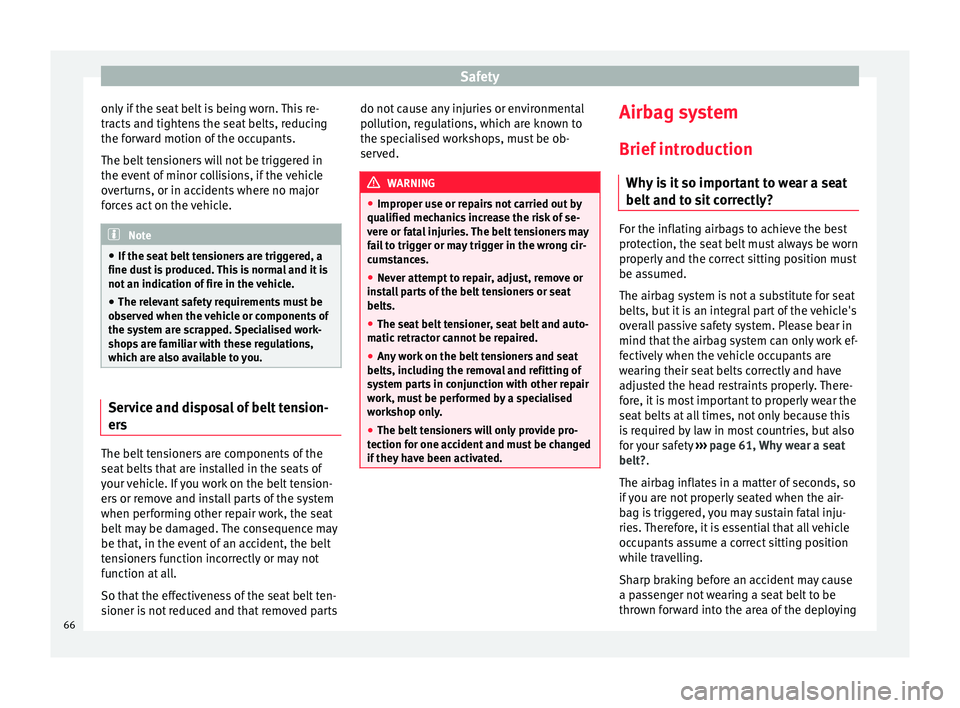
Safety
only if the seat belt is being worn. This re-
tr acts
and tight en
s the seat belts, reducing
the forward motion of the occupants.
The belt tensioners will not be triggered in
the event of minor collisions, if the vehicle
overturns, or in accidents where no major
forces act on the vehicle. Note
● If the seat belt
tensioners are triggered, a
fine dust is produced. This is normal and it is
not an indication of fire in the vehicle.
● The relevant safety requirements must be
observ
ed when the vehicle or components of
the system are scrapped. Specialised work-
shops are familiar with these regulations,
which are also available to you. Service and disposal of belt tension-
er
s The belt tensioners are components of the
se
at
belts th
at are installed in the seats of
your vehicle. If you work on the belt tension-
ers or remove and install parts of the system
when performing other repair work, the seat
belt may be damaged. The consequence may
be that, in the event of an accident, the belt
tensioners function incorrectly or may not
function at all.
So that the effectiveness of the seat belt ten-
sioner is not reduced and that removed parts do not cause any injuries or environmental
pollution, re
gulations, which are known to
the specialised workshops, must be ob-
served. WARNING
● Improper use or r ep
airs not carried out by
qualified mechanics increase the risk of se-
vere or fatal injuries. The belt tensioners may
fail to trigger or may trigger in the wrong cir-
cumstances.
● Never attempt to repair, adjust, remove or
insta
ll parts of the belt tensioners or seat
belts.
● The seat belt tensioner, seat belt and auto-
matic retr
actor cannot be repaired.
● Any work on the belt tensioners and seat
belts, including the r
emoval and refitting of
system parts in conjunction with other repair
work, must be performed by a specialised
workshop only.
● The belt tensioners will only provide pro-
tection for one acc
ident and must be changed
if they have been activated. Airbag system
Brief intr
oduction
Wh y
is it so important to wear a seat
belt and to sit correctly? For the inflating airbags to achieve the best
protection, the se
at
belt must always be worn
properly and the correct sitting position must
be assumed.
The airbag system is not a substitute for seat
belts, but it is an integral part of the vehicle's
overall passive safety system. Please bear in
mind that the airbag system can only work ef-
fectively when the vehicle occupants are
wearing their seat belts correctly and have
adjusted the head restraints properly. There-
fore, it is most important to properly wear the
seat belts at all times, not only because this
is required by law in most countries, but also
for your safety ›››
page 61, Why wear a seat
belt?.
The airbag inflates in a matter of seconds, so
if you are not properly seated when the air-
bag is triggered, you may sustain fatal inju-
ries. Therefore, it is essential that all vehicle
occupants assume a correct sitting position
while travelling.
Sharp braking before an accident may cause
a passenger not wearing a seat belt to be
thrown forward into the area of the deploying
66
Page 69 of 252
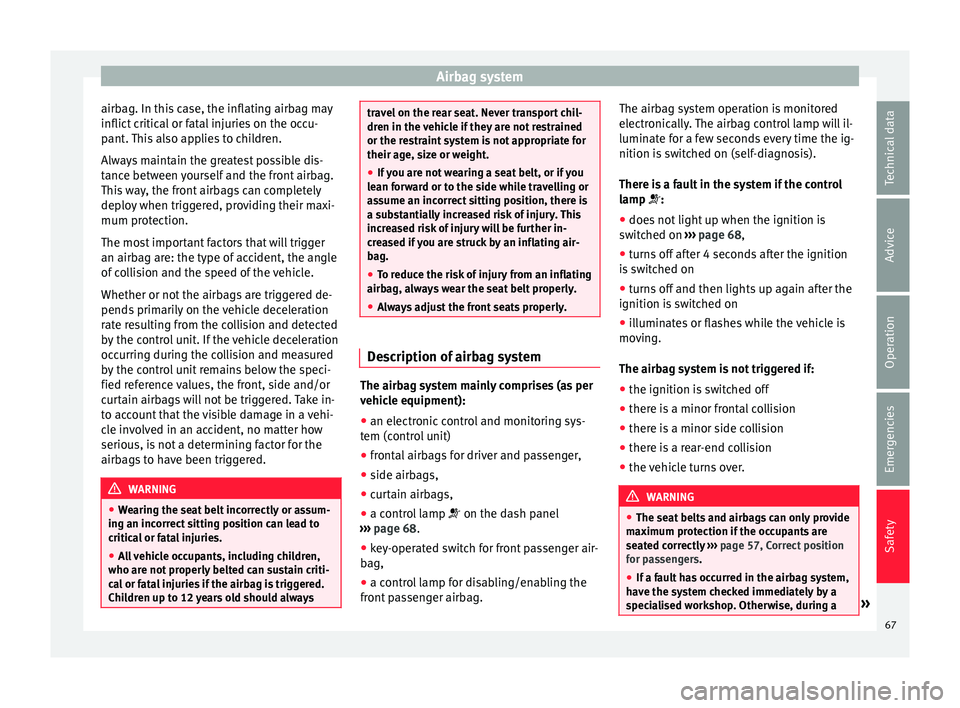
Airbag system
airbag. In this case, the inflating airbag may
inflict c
ritic al
or fatal injuries on the occu-
pant. This also applies to children.
Always maintain the greatest possible dis-
tance between yourself and the front airbag.
This way, the front airbags can completely
deploy when triggered, providing their maxi-
mum protection.
The most important factors that will trigger
an airbag are: the type of accident, the angle
of collision and the speed of the vehicle.
Whether or not the airbags are triggered de-
pends primarily on the vehicle deceleration
rate resulting from the collision and detected
by the control unit. If the vehicle deceleration
occurring during the collision and measured
by the control unit remains below the speci-
fied reference values, the front, side and/or
curtain airbags will not be triggered. Take in-
to account that the visible damage in a vehi-
cle involved in an accident, no matter how
serious, is not a determining factor for the
airbags to have been triggered. WARNING
● Wearin g the se
at belt incorrectly or assum-
ing an incorrect sitting position can lead to
critical or fatal injuries.
● All vehicle occupants, including children,
who are not properly
belted can sustain criti-
cal or fatal injuries if the airbag is triggered.
Children up to 12 years old should always travel on the rear seat. Never transport chil-
dren in the v
ehic
le if they are not restrained
or the restraint system is not appropriate for
their age, size or weight.
● If you are not wearing a seat belt, or if you
lean for
ward or to the side while travelling or
assume an incorrect sitting position, there is
a substantially increased risk of injury. This
increased risk of injury will be further in-
creased if you are struck by an inflating air-
bag.
● To reduce the risk of injury from an inflating
airbag, alwa
ys wear the seat belt properly.
● Always adjust the front seats properly. Description of airbag system
The airbag system mainly comprises (as per
v
ehic
le equipment):
● an el
ectronic control and monitoring sys-
tem (contro
l unit)
● frontal airbags for driver and passenger,
● side airbags,
● curtain airbags,
● a control lamp on the dash panel
›
›› page 68.
● key-operated switch for front passenger air-
bag,
● a contro
l lamp for disabling/enabling the
front pa
ssenger airbag. The airbag system operation is monitored
electronical
ly. The airbag control lamp will il-
luminate for a few seconds every time the ig-
nition is switched on (self-diagnosis).
There is a fault in the system if the control
lamp :
● does not light up when the ignition is
switched on ›
›› page 68,
● turns off after 4 seconds after the ignition
is swit
ched on
● turns off and then lights up again after the
ignition is swit
ched on
● illuminates or flashes while the vehicle is
moving.
The airb
ag system is not triggered if:
● the ignition is switched off
● there is a minor frontal collision
● there is a minor side collision
● there is a rear-end collision
● the vehicle turns over. WARNING
● The seat belt s
and airbags can only provide
maximum protection if the occupants are
seated correctly ››› page 57, Correct position
for passengers.
● If a fault has occurred in the airbag system,
have the sys
tem checked immediately by a
specialised workshop. Otherwise, during a » 67
Technical data
Advice
Operation
Emergencies
Safety
Page 70 of 252
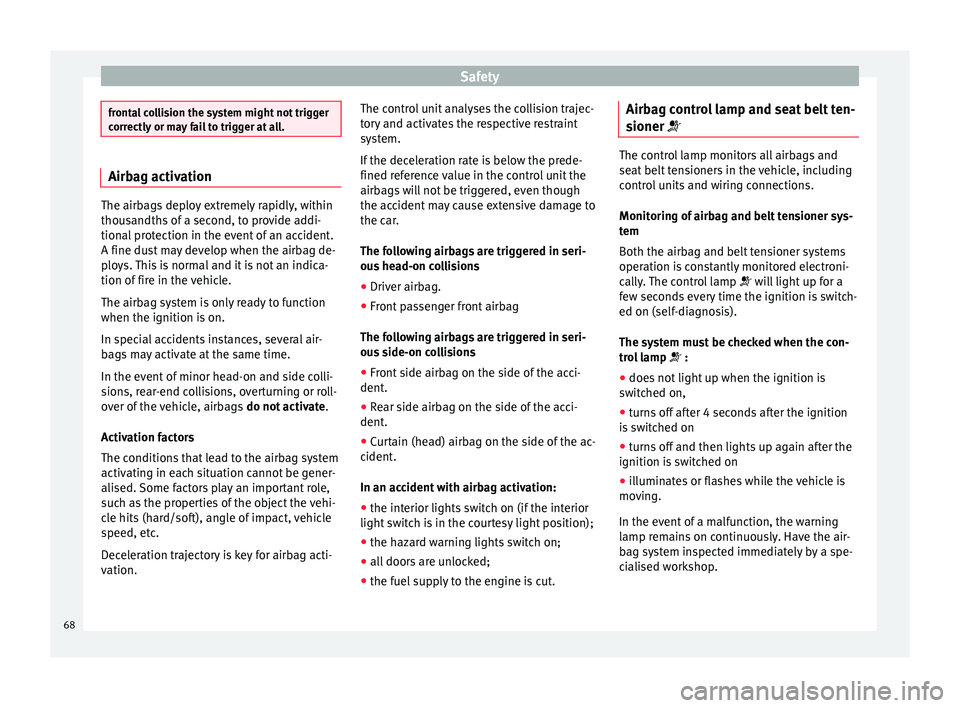
Safety
frontal collision the system might not trigger
correctly
or m
ay fail to trigger at all.Airbag activation
The airbags deploy extremely rapidly, within
thousandths
of
a second, to provide addi-
tional protection in the event of an accident.
A fine dust may develop when the airbag de-
ploys. This is normal and it is not an indica-
tion of fire in the vehicle.
The airbag system is only ready to function
when the ignition is on.
In special accidents instances, several air-
bags may activate at the same time.
In the event of minor head-on and side colli-
sions, rear-end collisions, overturning or roll-
over of the vehicle, airbags do not activate.
Activation factors
The conditions that lead to the airbag system
activating in each situation cannot be gener-
alised. Some factors play an important role,
such as the properties of the object the vehi-
cle hits (hard/soft), angle of impact, vehicle
speed, etc.
Deceleration trajectory is key for airbag acti-
vation. The control unit analyses the collision trajec-
tory
and activ
ates the respective restraint
system.
If the deceleration rate is below the prede-
fined reference value in the control unit the
airbags will not be triggered, even though
the accident may cause extensive damage to
the car.
The following airbags are triggered in seri-
ous head-on collisions
● Driver airbag.
● Front passenger front airbag
The follo
wing airbags are triggered in seri-
ous side-on collisions
● Front side airbag on the side of the acci-
dent.
● Rear s
ide airbag on the side of the acci-
dent.
● Curt
ain (head) airbag on the side of the ac-
cident.
In an acc
ident with airbag activation:
● the interior lights switch on (if the interior
light switc
h is in the courtesy light position);
● the hazard warning lights switch on;
● all doors are unlocked;
● the fuel supply to the engine is cut. Airbag control lamp and seat belt ten-
sioner The control lamp monitors all airbags and
seat belt
t
ensioners in the vehicle, including
control units and wiring connections.
Monitoring of airbag and belt tensioner sys-
tem
Both the airbag and belt tensioner systems
operation is constantly monitored electroni-
cally. The control lamp will light up for a
few seconds every time the ignition is switch-
ed on (self-diagnosis).
The system must be checked when the con-
trol lamp :
● does not light up when the ignition is
switc hed on,
● t
urns off after 4 seconds after the ignition
is swit
ched on
● turns off and then lights up again after the
ignition is swit
ched on
● illuminates or flashes while the vehicle is
moving.
In the ev
ent of a malfunction, the warning
lamp remains on continuously. Have the air-
bag system inspected immediately by a spe-
cialised workshop.
68